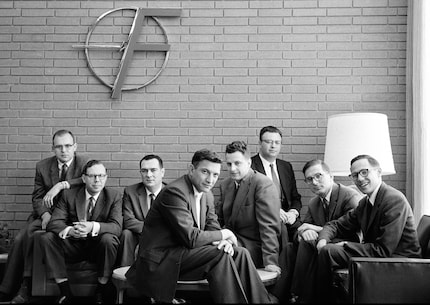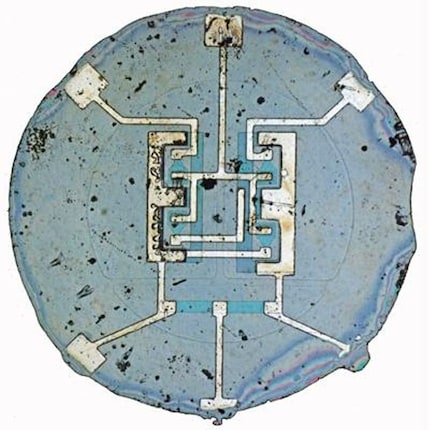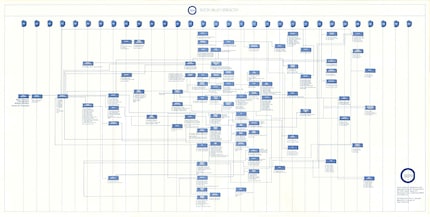
Guide
History of computing part 4: Transistors - thanks to them your computer runs
by Kevin Hofer

Without integrated circuits, planar technology and Moore's law, computers would not exist in their current form. All of these inventions were made by the founders of Fairchild Semiconductor Corporation.
Between 1947 and 1948, William B. Shockley invented the transistor together with John Bardeen and Walter H. Brattain. The most important invention of the 20th century earned him and his colleagues the Nobel Prize in Physics in 1956.
Shockley was undoubtedly a genius. But he also had another side. He was anything but an affable person. For one thing, the physicist, who was born in London in 1910, was a racist. Shockley was convinced that whites were intellectually superior to blacks. He was an advocate of eugenics and suggested sterilising the "genetically inferior".
On the other hand, Shockley was probably the worst manager in the history of electronics. He failed to inspire and motivate his undoubtedly brilliant employees. The opposite was the case. He told his subordinates straight to their faces that they were no good. He is even said to have taken a compulsory lie detector test because he suspected his employees of sabotage. He kept records on every employee and made blunt and arbitrary decisions.
In short, Shockley was a brilliant but racist tyrant. His miserable management style was a stroke of luck for the history of computing: it led to eight senior employees leaving the Shockley Semiconductor Laboratory and founding the Fairchild Semiconductor Corporation in 1957. It was so named because the founders were financially supported by Sherman Fairchild, an investor, inventor and businessman.

Shockley referred to his eight former employees as the "Traitorous Eight" because he felt betrayed by them. They were not deterred by this and developed an improved silicon transistor. This sold like hot cakes in the aviation and military sectors.
The company quickly gained a reputation. By 1960, the company's sales had already exceeded 20 million dollars and the Fairchild Semiconductor Corporation was regarded as a leader in the field of transistors. However, the company's founders were not resting on their laurels.
It was Jean Hoerni - one of the founders of Fairchild Semiconductor Corporation - who discovered that a silicon oxide layer on the silicon wafers reduced impurities during the manufacturing process. The transistors were cut from the silicon wafers. Hoerni's invention made it possible to increase production as fewer rejects were produced. The planar technology was born.

Fairchild Semiconductor Corporation's first integrated circuit
computerhistory.org
Robert Noyce - a founder of Fairchild Semiconductor Corporation - pushed the development of Hoerni even further. He realised that it was not necessary to cut the silicon wafers: The individual components can be placed on them and connected by conductive material. Noyce thus developed a process for manufacturing integrated circuits - or chips.
From 1961, the Fairchild Semiconductor Corporation sold chips with integrated circuits for 120 dollars each. Thanks to the Apollo programme, sales were also good: one million integrated circuits were purchased for the moon landing project, most of them from Fairchild Semiconductor Corporation.
But the planar technology and the chip were not the end of the story. Another founder of the Fairchild Semiconductor Corporation was Gordon Moore. In 1965, he observed that the number of components on integrated circuits was continuously increasing. Originally, Moore spoke of a doubling per year. The Moore's Law was born.
Together with planar technology and the chip, Moore's Law was the initial spark for innovation and entrepreneurship in Silicon Valley. However, the Fairchild Semiconductor Corporation became a victim of its own success. A large number of spin-offs emerged that competed with the company over time. This began in 1959 with the unsuccessful Rheem Semiconductor.

you can find the zoomable representation.
chiphistory.org
Over the years, more and more spin-offs - so-called "fairchildren" - have been added. The best known is Intel, which was founded by Robert Noyce and Gordon Moore in 1968. But AMD, Altera, LSI Logic, National Semiconductor and SanDisk are also among the fairchildren.
By the end of the 1970s, Fairchild Semiconductor Corporation could no longer compete with the Fairchildren. Various takeovers followed. Since 2016, the company has been in the hands of semiconductor manufacturer ON Semiconductor.
The Fairchildren, on the other hand, established the reputation of Silicon Valley and some of them are still extremely successful today.
From big data to big brother, Cyborgs to Sci-Fi. All aspects of technology and society fascinate me.
Interesting facts about products, behind-the-scenes looks at manufacturers and deep-dives on interesting people.
Show all